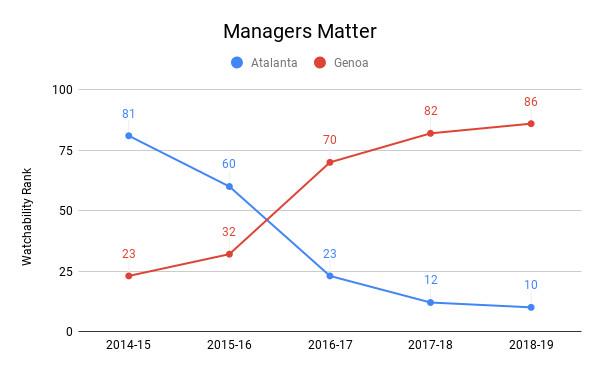
Earlier this month, we introduced The Ringer’s Soccer Watchability Rankings, which aim to measure how much joy a given soccer team imparts unto its viewers on an aesthetic basis. With every team in Europe’s big five leagues having played at least one game in the 2018-19 season, we can unveil the 2018-19 rankings, which will be updated each week through May.
Read the introductory post for a more detailed methodology, but essentially, the rankings rate each team on four factors related to the sport’s four main areas of action: dribbling, passing, defending, and shooting. Those factors are, respectively, attempted dribbles, deep completions, passes allowed per defensive action, and expected goals, and together they account for a given club’s holistic experience. It’s still incredibly early in the 2018-19 European campaign, but the numbers are already illuminating; here are a handful of revealing trends from the first edition of this season’s rankings.
Soccer Watchability 2018-19 (through Aug. 28)
1. Barcelona Isn’t No. 1 (for Now)
Historical data at Understat.com extends back to 2014-15, so this is the fifth season for which we can calculate the rankings. In each of the last four, Barcelona placed first overall, and after the club’s first game this season, it was no. 1 again (albeit unofficially, because with no Bundesliga games yet at that point, the full rankings couldn’t be computed). Then the Catalan giants played on such a pockmarked pitch against Real Valladolid that offensive tactics were almost uniformly nullified. Barcelona won 1-0, registered only 1.2 expected goals, and thus fell out of the top spot.
In its stead bursts Liverpool, riding high on Jürgen Klopp’s gegenpressing coattails and happy to assume the lead in both the watchability rankings and the Premier League table. This item isn’t to suggest that Barcelona is any less fun to watch this year, but rather to emphasize the fact that because they’re drawing on a sample of just a couple of games—or, in the Bundesliga’s case, just one—these first-edition rankings are prone to all sorts of contextual fluctuations that should even out over the course of the season: weather, field quality, opponent quality, a World Cup hangover effect, and so on. Don’t take these standings as gospel, basically. There’s no reason for Barcelona to be concerned about their reign ending just yet.
2. Wait … Bournemouth?
Yes, the Cherries aren’t just a surprise team near the top of the Premier League standings; they’re a darn watchable group as well. Even with Barcelona vacating their throne for the moment, the top chunk of the rankings is already conforming to its typical look: Liverpool ranked eighth last season, while the rest of the clubs in the top five are making repeat appearances.
Then there’s Bournemouth in sixth place, thanks to a well-rounded effort. On a per-game basis, they’re 11th (in a tie) in dribbles, seventh in deep completions, and 14th in xG, as well as an above-average team in PPDA. Bournemouth placed 69th in these rankings a season ago, after finishing 38th and 41st in the two preceding seasons, so even this glimmer of fun represents a monumental improvement from recent form.
The Cherries’ early schedule has played an obvious role, given that they opened the season with Cardiff and have since faced league doormat West Ham and Everton, who played more than half of the game with 10 men, but give Eddie Howe’s group credit: Forward Joshua King is tied for second in the Premier League with six attempted dribbles per game, and Callum Wilson leads all of England in xG (2.79). Second place behind Wilson is Mo Salah; third is Sergio Agüero. This run likely won’t continue, on either an individual or team basis—if Bournemouth remain in the top 10 all season, Donnie Kwak will eat a boot—but celebrate the surprising uptick while it lasts. That’s the point of these rankings, after all.
3. Atalanta’s Rise Shows That Managers Matter
Here is a graph charting the watchability rankings over five seasons for two Serie A teams. (Because it shows rankings, lower numbers are better.) Guess what year Genoa’s manager departed for Atalanta!

Gian Piero Gasperini has been coaching in some form in Italy for a quarter-century, and in that time he has been perhaps best known for his infamous tenure with Inter Milan, when he was sacked after just five matches during which his team posted four losses and one draw. But the 60-year-old Italian has consistently overseen a swashbuckling style—José Mourinho once called him “the coach that makes it the most difficult for me”—and that graph, which details the effect Gasperini’s move from Genoa to Atalanta for the 2016-17 season wrought on both clubs, reflects the instant impact a manager with a cohesive approach can make.
He gets results, too: In Gasperini’s first year at the helm, Atalanta finished fourth in Serie A, and although the club dropped to seventh last year, it was third on expected points based on its xG totals for and against. Thus far in 2018-19, Atalanta has romped 4-0 over recently promoted Frosinone and tied Roma 3-3 in a delectable affair. The two clubs combined for 48 shots, which was the most in any Serie A game since 2010. Keep (or start) watching Atalanta; Gasperini will make sure you enjoy yourself.
4. Manchester United Are What We Thought They Were
Mourinho’s praise of Gasperini might have been notable earlier this decade, but these days, a scarecrow with a British accent might prove a puzzle for the Special One. Manchester United are reeling after a loss to Brighton and a 3-0 shellacking against Tottenham, and even in their lone win of the young season, an opening victory against Leicester, United were outperformed in all four statistics that make up the watchability rankings.
In addition to highlighting under-the-radar teams worth greater attention, these rankings can also be used to support—or oppose—narratives gleaned from other means. In this case, United’s standing confirms much of the criticism leveled against Mourinho’s group: They don’t rank better than 31st in any of the four categories and place 47th overall; even in the Louis van Gaal years, United never fell below 26th in overall watchability. The club still has plenty of time to reverse its slide, but the problems are widespread and stem from a broad lack of creativity and incisive offensive play. Over the whole season, United have collected just 15 deep completions; Liverpool have at least 14 in every game. Even in its best category thus far, xG, the club has benefited from a couple of penalty attempts, which are unlikely to recur at this rate the rest of the season.
One wonders how high United might rise if—or, at this point, when—they sever ties with Mourinho.
5. This Isn’t the Place to Look for a Ronaldo Effect
Without the superstar who defined the club’s last decade of winning soccer, Real Madrid have fallen all the way from fourth place in watchability in 2017-18 to fifth place this season. Meanwhile, after adding that generational talent, Juventus haven’t improved at all, and have dropped from 23rd to 29th. Again, neither of these shifts matter all that much at this juncture, but it is notable that Cristiano Ronaldo’s transfer hasn’t changed either team’s stylistic results by any manner of recognizable magnitude yet.
Perhaps that outcome isn’t so surprising, though. Ronaldo doesn’t attempt take-ons much anymore, as his dribbles declined from 6.2 per game in his first season with Madrid to just 1.9 last year. He certainly doesn’t provide much—if any—defensive activity, but Juventus were a below-average pressing team last year, so he’s not adversely affecting the strategy in Turin. And while he still produces plenty of exciting chances—in all of Europe last season, only Lionel Messi and Robert Lewandowski amassed more individual xG—Madrid has the talent to redistribute those chances, and Gonzalo Higuaín, the man he’s replacing in Juventus’s 11, was no slouch, either.
Ronaldo’s presence alone might make Juventus more watchable, and Madrid less so, but there’s no superstar variable in these rankings. Perhaps that’s a methodological shortcoming, but let’s face facts: Even if there were, Juventus wouldn’t be nearly as watchable as Bournemouth.

